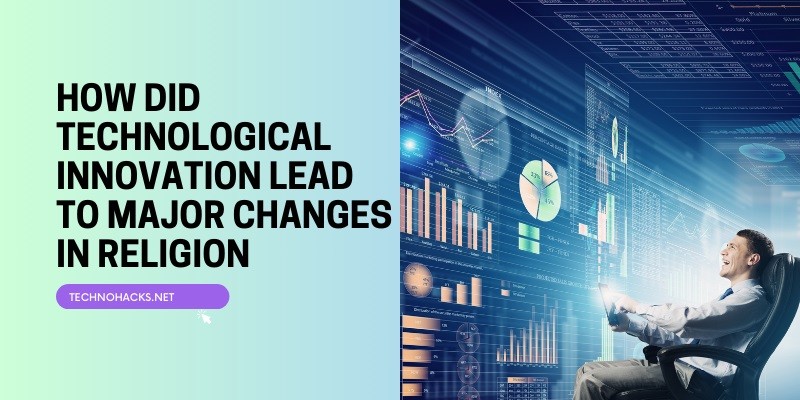How Did Technological Innovation Lead To Major Changes In Religion?
Technological innovation has been a driving force behind major changes in many aspects of society, and religion is no exception. Throughout history, various technological advancements have revolutionized how religious ideas are disseminated, practiced, and perceived. This article delves into the profound impact of technological innovation on religion, tracing the journey from the invention of the printing press to the digital age.
Historical Context
The Printing Press
The printing press, invented by Johannes Gutenberg in the 1450s, was a revolutionary invention that changed the world of communication, education, and culture. One of the most significant impacts of the printing press was on religion, especially Christianity.
- Mass Production of Religious Texts: Before the printing press, books were handwritten by scribes, making them expensive and prone to errors. The printing press enabled mass production and accurate reproduction, making religious texts like the Bible more accessible to the masses.
- Translation into Vernacular Languages: The Bible, previously available only in Latin, was translated into vernacular languages (e.g., German, English). This democratized religious knowledge, allowing ordinary people to read and interpret the scriptures themselves.
- Facilitation of Protestant Reformation: The printing press played a crucial role in the Protestant Reformation by enabling reformers like Martin Luther to disseminate their ideas quickly and widely. Luther’s theses spread rapidly across Europe, challenging the Catholic Church’s authority and doctrines and sparking religious debates and movements.
20th Century Innovations
Radio
Radio emerged as a powerful tool for religious broadcasting in the 20th century. The first religious radio broadcast in 1921 paved the way for many more, allowing religious messages to reach isolated communities.
- Expansion of Reach: Radio enabled religious leaders to share sermons and teachings with a broader audience, fostering a sense of community among listeners.
- Rise of Megachurches: The ability to broadcast sermons contributed to the rise of megachurches, where large congregations are drawn by charismatic leaders whose messages could be heard far and wide.
Television
Television further expanded the reach of religious programming.
- Evangelical Movements and Televangelism: Television played a pivotal role in the spread of evangelical movements, with televangelists reaching millions of viewers. Prominent figures like Billy Graham utilized television broadcasts to spread their messages globally.
- Influence on Practices and Community Engagement: The visual and auditory appeal of television impacted how religious practices were conducted and how communities engaged with their faith.
The Digital Age
The Internet
The advent of the internet marked a paradigm shift in how people engage with religion.
- Access to Religious Resources: The internet provides vast access to religious texts, resources, and educational materials. Individuals can explore diverse religious perspectives from the comfort of their homes.
- Online Communities and Forums: Virtual communities and forums offer spaces for religious discussions, allowing people from different backgrounds to connect and share their beliefs.
- Virtual Worship Services and Online Giving Platforms: The COVID-19 pandemic accelerated the trend of virtual worship services, enabling congregations to participate in services online. Online giving platforms have also facilitated donations and charitable activities.
- Impact on Religious Affiliation: Research from the Pew Research Center indicates that secularization is increasing partly due to easy access to diverse information online. The ‘nones’—individuals who do not identify with any religion—are on the rise.
Smartphones and Mobile Apps
Mobile technology has further personalized religious experiences.
- Religious Apps: Various apps provide tools for prayer, meditation, scripture reading, and religious education. These apps offer convenience, making it easier for individuals to integrate religious practices into their daily lives.
- Concerns about Community Aspect: While technology provides individual flexibility, it also raises concerns about diminishing face-to-face interactions and communal worship experiences.
Artificial Intelligence and Emerging Technologies
AI in Religious Studies
Advanced technologies like AI are transforming religious studies:
- Deciphering Ancient Texts: AI aids in deciphering and translating ancient religious manuscripts, preserving valuable historical knowledge.
- Restoration of Artifacts: AI technologies assist in preserving and restoring religious artifacts, safeguarding cultural heritage.
- Virtual Religious Guides: AI-powered virtual guides provide personalized religious teachings and support, making spirituality more accessible.
Automation and Religiosity
Studies indicate a potential correlation between increased automation exposure and declining religiosity.
- Instrumental Value vs. Technology: As technological solutions address various needs previously met by religion, some individuals may find less instrumental value in traditional religious practices.
- Implications for Ethical Decision-Making: The rise of AI prompts debates about ethics and morality, areas traditionally governed by religious teachings.
Pros and Cons of Technological Impact on Religion
Pros
- Enhanced Accessibility: Technology makes religious knowledge more accessible to a wider audience.
- Global Connectivity: Online platforms strengthen global religious communities, fostering intercultural dialogue.
- Innovative Practices: Technology introduces innovative ways to practice faith, from virtual reality pilgrimages to interactive prayer apps.
Cons
- Misinformation Risks: The internet can spread misinformation or misrepresent religious teachings, leading to confusion and division.
- Erosion of Communal Worship: Over-reliance on technology may undermine traditional communal worship practices, affecting social cohesion within religious communities.
- Authenticity Challenges: Digital interactions may lack the depth and authenticity of face-to-face religious experiences.
Conclusion
In conclusion, technological innovation has profoundly influenced religion in multiple ways. From the revolutionary impact of the printing press to the transformative effects of the internet and AI, technology continues to shape how people practice, perceive, and engage with their faith. While it presents opportunities for enhanced accessibility and global connectivity, it also poses challenges that require careful navigation. As technology evolves, so too will its impact on religion, necessitating a balance between embracing innovation and preserving cherished traditions.

